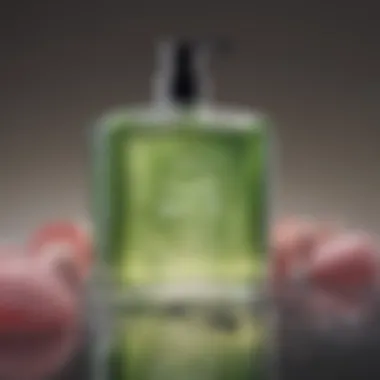Exploring Top Liquid Bath Soap Brands and Their Benefits


Intro
The realm of liquid bath soap brands has evolved significantly in recent years. Consumers are increasingly aware of the ingredients in their products and how these choices affect their health and the environment. This article delves into the various aspects of liquid bath soap brands, from their formulations and benefits to sustainability practices that consider both consumer and environmental needs.
Understanding these elements can greatly influence consumers’ choices in a market filled with diverse offerings. By exploring key brands, this article will provide a comprehensive guide that aims to educate readers and help them make informed decisions tailored to their individual preferences.
Composition of Liquid Bath Soaps
Liquid bath soaps are not all the same. Different brands use various ingredients that can influence both the soap's effectiveness and the user experience. Generally, liquid bath soaps can contain surfactants, moisturizers, fragrances, and preservatives.
Key aspects of the composition include:
- Surfactants: These are the main cleansing agents that help remove dirt and oil from the skin. Popular surfactants include sodium lauryl sulfate and cocamidopropyl betaine.
- Moisturizing Agents: Ingredients such as glycerin, aloe vera, and various oils help maintain skin hydration, making soaps more than just cleansing agents.
- Fragrances: Scent can greatly affect the bath experience. Brands often use both synthetic and natural fragrances.
- Preservatives: These are essential for preventing microbial growth in liquid formulations. Common preservatives are phenoxyethanol and ethylhexylglycerin.
In the sections below, we will analyze specific brands and their unique formulations.
Benefits of Liquid Bath Soap
Liquid bath soaps offer several advantages that can be appealing to various consumers. Some of these benefits include:
- Convenience: Liquid soaps often come in pump bottles, making them easy to dispense and reducing contamination risk.
- Ease of Use: Liquid bath soaps are often favored for their ability to create rich lather, making the bathing experience feel luxurious.
- Variety of Formulations: There are options available for different skin types and preferences, such as sensitive skin formulations or eco-friendly products.
- Hydration: Many brands prioritize skin care in their formulations, providing hydration that bar soaps may lack.
As we proceed through top brands and their offerings, it becomes clear how these benefits serve different consumer needs.
Sustainability Practices
In today’s market, sustainability is a key consideration for many shoppers. Several liquid bath soap brands are increasingly focusing on eco-friendly practices. This includes:
- Sourcing of Ingredients: Many brands are now opting for sustainably sourced, organic ingredients that minimize environmental impact.
- Packaging: A shift towards less plastic and more biodegradable or recyclable packaging is evident in many products.
- Manufacturing Processes: Eco-conscious brands invest in renewable energy sources and responsible waste management practices in their production lines.
"The emphasis on sustainability reflects a broader commitment among consumers to mindful choices."
This sustainability movement is reshaping product development and market presence, compelling brands to innovate continually.
By understanding these aspects, one can appreciate the broader landscape of liquid bath soap brands. The next sections will provide a detailed analysis of leading brands, examining their unique contributions to the market.
Intro to Liquid Bath Soap
Liquid bath soap is a significant part of personal hygiene and skincare routines for many people around the world. Its popularity lies in its versatility and accessibility. Unlike traditional bar soaps, liquid options often provide a more hygienic approach to cleansing. This article explores various aspects of liquid bath soap, from definitions to consumer preferences, providing insights into key ingredients and the top brands available.
Definition and Uses
Liquid bath soap, typically a mixture of cleansing agents, water, and other ingredients, serves the primary purpose of cleansing the skin. This type of soap is designed to rinse off easily, leaving the skin clean and fresh. It can be used in various settings, such as homes, hotels, and spas. The formulation often includes moisturizers to prevent skin dryness, as well as fragrance for a pleasant experience during washing.
It is essential for consumers to choose a product based on their skin type and specific needs. For instance, those with sensitive skin may benefit from products with minimal ingredients and soothing properties. Furthermore, liquid bath soaps can also vary by purpose, with some designed specifically for cleansing the body, while others can be used for both body and handwashing.
Evolution of Liquid Bath Soap
The evolution of liquid bath soap is a fascinating chronicle of changing consumer preferences and advances in formulation chemistry. Initially, soap was produced in a solid form, with liquid variations emerging later as personal care needs evolved. In the 20th century, liquid soaps gained popularity due to their convenience and ease of use. The introduction of pump dispensers made them even more user-friendly, reducing the risk of contamination often associated with bar soaps.
In recent years, the market has seen a shift towards more natural, eco-friendly formulations. Consumers increasingly demand transparency in ingredient quality and sustainability in production. This trend is shaping the future landscape of liquid bath soaps, showing an increasing preference for brands that prioritize ethical sourcing and environmentally friendly practices. Overall, the evolution reflects a growing awareness of health, hygiene, and environmental impact among consumers.
Key Ingredients in Liquid Bath Soap
Liquid bath soap formulations are an intricate blend of various components that ensure their effectiveness and appeal to consumers. Understanding key ingredients is essential, as they not only determine the overall quality of the product but also influence skin health, user experience, and safety. This section dives into the main categories of constituents that form the backbone of liquid bath soaps. By exploring cleansing agents, moisturizers, conditioners, fragrances, and preservatives, readers can better appreciate the complexities involved in product selection.


Cleansing Agents
Cleansing agents are at the heart of any liquid bath soap. These ingredients enable the removal of dirt, oils, and impurities from the skin, thus ensuring a clean and refreshed feeling after use. There are various types of cleansing agents used in formulations, each serving a distinct purpose in the cleansing process.
Common cleansing agents include:
- Surfactants: These are the primary ingredients responsible for foaming and emulsifying. They reduce the surface tension of water, allowing it to mix more readily with oils and dirt.
- Synthetic and natural options: Some brands use synthetic surfactants like Sodium Lauryl Sulfate, while others opt for natural surfactants derived from plants, such as coco-glucoside.
While effective cleansing is vital, the type of cleansing agent chosen also affects skin irritation levels. Natural surfactants are often recommended for sensitive skin types, as they tend to be gentler and less irritating than their synthetic counterparts. Opting for a product with a balanced formulation is crucial for maintaining skin health.
Moisturizers and Conditioners
Moisturizers and conditioners are pivotal for combating the drying effects that cleansing agents may impose on the skin. Their addition in liquid bath soaps allows for a more nourishing process, making the clean not just effective but also soothing.
Common moisturizing and conditioning ingredients include:
- Glycerin: This is a widely-used humectant that attracts moisture to the skin, helping maintain hydration levels effectively.
- Natural oils: Ingredients like coconut oil, olive oil, or shea butter provide essential fatty acids that nourish the skin.
- Aloe Vera: Known for its soothing properties, Aloe Vera not only moisturizes but also provides anti-inflammatory benefits, making it suitable for various skin types.
Users who prioritize hydration will often seek liquid bath soaps that prominently feature these ingredients, especially those labeled as "moisturizing" or "hydrating." The efficacy of these components enhances the post-cleansing experience, ensuring that the skin feels soft and supple rather than stripped of its natural oils.
Fragrance and Preservatives
Fragrance is an important yet polarizing ingredient in liquid bath soap. While many consumers gravitate towards pleasant scents, it's essential to recognize that fragrances can trigger reactions in sensitive individuals. Ingredients such as essential oils are often used in place of synthetic fragrances, providing a more natural scent experience.
Preservatives, on the other hand, play a critical role in maintaining product integrity. They prevent the growth of harmful microorganisms in liquid formulations. Common preservatives include:
- Phenoxyethanol: This is often cited as a safer alternative to parabens.
- Sodium Benzoate: Less irritating, it also helps in preventing fungal growth, making it popular in many cosmetic formulas.
It's important to read labels and understand the purpose of each ingredient. Educating yourself about potential irritants or allergens can enhance your skincare approach.
Top Liquid Bath Soap Brands
In exploring liquid bath soap brands, it is essential to consider the significant impact they have on consumer choices and experiences. Each brand brings its unique formulations and benefits. Understanding these options helps consumers identify products that align with their specific skin types, ethical considerations, and overall preferences. It is valuable for buyers to be informed of the various brands available, as this knowledge facilitates more thoughtful purchasing decisions. This section highlights notable brands, aiming to inform consumers about their distinctive features and market presence.
Brand A: Overview and Unique Features
Brand A, known for its commitment to quality, stands out in the competitive liquid bath soap market. Their products are formulated with natural ingredients, aiming to provide effective cleansing without stripping the skin's moisture. A defining feature of Brand A is its fragrance-free line, catering specifically to individuals with sensitive skin. The brand prioritizes transparency in its ingredient sourcing and formulations, which resonates with many consumers today who emphasize ethical sourcing.
Additionally, Brand A often focuses on eco-friendly packaging solutions, making it a preferred choice among environmentally conscious consumers. Their ability to blend effectiveness with a commitment to sustainability positions them favorably in the marketplace, appealing especially to women looking for gentle yet effective solutions for their skin care needs.
Brand B: Market Position and Reputation
Brand B commands a strong position in the liquid bath soap market, recognized for its widespread popularity and positive reputation. The brand has built trust through consistent quality and innovation in its product offerings. Market research indicates that customers frequently associate Brand B with reliability and effectiveness in maintaining skin health.
This brand invests in scientific research to develop formulas that cater to diverse skin types. For example, they produce options for dry, oily, and combination skin, which enhances their appeal across various demographics. Brand B also engages in targeted marketing, emphasizing its reputation for hypoallergenic products. This strategy has established a loyal customer base among women of all ages, who appreciate the brand's focus on safety and efficacy.
Brand C: Product Range and Target Audience
Brand C distinguishes itself with an expansive product range that caters to a broad audience. They offer a variety of liquid bath soaps, including options infused with vitamins and essential oils, designed to meet particular needs. This includes products aimed at calming sensitive skin, rejuvenating mature skin, and refreshing oily skin.
The brand's marketing strategy emphasizes inclusivity, ensuring they appeal to consumers from diverse backgrounds. By tailoring their products to specific demographics, Brand C attracts attention not just from women but from families seeking holistic skin care solutions for everyone. They also have an active presence on platforms like Reddit and Facebook, where they engage with consumers for feedback and product improvements, further solidifying their reputation. Their approach reflects a keen understanding of consumer needs and strengthens their positioning in the competitive landscape of liquid bath soaps.


"Understanding brand offerings enables consumers to choose products that align with their skincare needs and values."
Consumer Preferences and Purchasing Trends
Understanding consumer preferences and purchasing trends is vital for comprehending the liquid bath soap market. These trends reflect what drives buyers to choose one product over another, allowing brands to tailor their offerings effectively. Factors such as changing lifestyles, increased awareness of sustainability, and economic variables shape these preferences significantly.
Factors Influencing Purchase Decisions
When it comes to purchasing liquid bath soap, several elements come into play. The most significant ones include:
- Brand Reputation: Consumers often gravitate towards established brands like Dove or Aveeno, believing that these companies provide a level of quality and trustworthiness.
- Product Ingredients: This factor is increasingly important. Shoppers seek transparency in the ingredients used, particularly as more people become aware of health and skin sensitivities. Products labeled as free from parabens or sulfates often attract health-conscious consumers.
- Scent and Texture: The sensory experience plays a crucial role in the decision-making process. Fragrances can evoke memories or stimulate emotions, leading consumers to prefer specific scents that resonate with them.
- Targeted Benefits: Some customers look for soaps that cater specifically to their individual needs, such as hydrating properties for dry skin or formulas that calm sensitive skin.
Sustainability and Ethical Considerations
Sustainability and ethical considerations are becoming central to many consumers' purchasing decisions. In the liquid bath soap market, this manifests in various ways:
- Eco-Friendly Ingredients: Buyers increasingly demand products formulated with natural ingredients that do not harm the environment. Brands often highlight their use of organic or sustainably sourced materials.
- Cruelty-Free Certifications: Many consumers seek assurance that their personal care products are not tested on animals. Products with cruelty-free labels often appeal to a more socially conscious consumer base.
- Sustainable Packaging: The increasing scrutiny on packaging waste has led consumers to prefer brands that use recyclable or biodegradable materials. This trend aligns with broader environmental movements, influencing shoppers to choose brands that prioritize reducing their ecological footprint.
Pricing Strategies and Value Perception
Pricing strategies significantly affect consumer behavior in the liquid bath soap segment. Various approaches can influence how a product is perceived in terms of value.
- Price vs. Quality: Consumers often correlate higher prices with better quality. Luxury brands like L’Occitane leverage this perception to position themselves as premium offerings in the market. On the other hand, budget brands need to convince buyers of their value despite lower prices.
- Promotions and Discounts: Special promotions and discounts can sway consumer choices, particularly among price-sensitive shoppers. Brands frequently run sales to attract new customers and encourage repeat purchases.
- Subscription Models: Emerging subscription services provide convenience and often introduce exclusive benefits for members. This model is appealing for shoppers looking for reliability and ease of access to their preferred products.
A nuanced understanding of consumer preferences not only helps brands refine their marketing strategies but also enhances customer satisfaction.
Health and Skin Benefits of Liquid Bath Soap
Liquid bath soap is more than just a cleansing agent; it encompasses a range of health benefits, particularly for the skin. Understanding these benefits is crucial for anyone looking to optimize their personal care routine. In the realm of personal hygiene, the choice of soap influences skin health significantly.
Not only does liquid soap provide physical cleansing, but it also aids in maintaining overall skin health. Many formulations are designed to be gentle, ensuring that they do not strip the skin of essential moisture. This feature is particularly important for individuals with sensitive or allergy-prone skin.
Gentle Cleansing for Sensitive Skin
People with sensitive skin often face challenges when it comes to selecting personal care products. Liquid bath soaps are typically crafted to offer a comforting cleansing experience. Many options are labeled as hypoallergenic, meaning they do not contain the harsh chemicals found in some traditional soaps.
Key benefits of gentle cleansing include:
- Reduced irritation: Gentle liquid soaps minimize redness and inflammation. This is vital for maintaining skin integrity and comfort.
- Safe for daily use: Formulations that are soothing often make it possible to cleanse the skin without adverse reactions, making them suitable for everyday application.
- Inclusive formulations: Certain brands develop products specifically for sensitive skin types, integrating additional soothing agents. Ingredients like aloe vera or chamomile are often added for their calming properties.
In summary, liquid bath soaps that prioritize gentle cleansing contribute significantly to skin health, especially for those who may react badly to more aggressive cleaning agents.
Hydration and Skin Barrier Maintenance
The skin's barrier function is a fundamental aspect of overall skin health. Liquid bath soaps that cater to hydration promote not only a cleansing action but also a protective one. Ingredients commonly found in these soaps are designed to support moisture retention, aiding in the prevention of dry skin.
Benefits include:
- Moisture-locking ingredients: Many liquid soaps feature humectants like glycerin. These ingredients draw moisture from the environment into the skin, helping to maintain hydration throughout the day.
- Support for the skin barrier: Formulations are sometimes enriched with fatty acids and vitamins. These compounds can bolster the skin's natural barrier, protecting it from irritants and environmental stressors.
- Elasticity and suppleness: Regular use of hydrating soaps contributes to an overall improvement in skin texture, allowing for soft, smooth skin that looks and feels healthy.
Additionally, the combination of gentle cleansing and hydration is particularly important as it prevents the skin from feeling tight or stripped, a common result of many soaps on the market today.


"Choosing the right liquid bath soap can greatly enhance skin health by providing both cleansing and hydration."
Overall, the health benefits of liquid bath soap extend beyond mere cleanliness. These properties allow individuals to maintain healthy skin while enjoying a cleansing experience that is both gentle and effective.
Environmental Impact of Liquid Bath Soaps
The environmental impact of liquid bath soaps is a significant concern in today's consumer landscape. As people's awareness grows regarding sustainability, it becomes crucial to understand how these products affect the planet. The production, packaging, and disposal of liquid bath soaps play vital roles in their overall environmental footprint. Brands and consumers alike must consider these factors to minimize negative impacts while maximizing benefits.
Production and Packaging Considerations
The production processes of liquid bath soaps vary widely among brands. Many companies seek to reduce their carbon footprint through sustainable practices. This can include sourcing ingredients from local suppliers to decrease transportation emissions. Furthermore, manufacturing techniques that use less energy and water contribute positively to environmental conservation.
Packaging also presents considerable challenges. Traditional plastic bottles are notoriously non-biodegradable, leading to significant waste. Many brands recognize this issue and are transitioning to eco-friendlier alternatives. Recyclable materials or biodegradable packaging can considerably lessen their environmental impact. Brands like Seventh Generation and Method have made strides in this area by investing in sustainable packaging solutions.
Utilizing refillable options and encouraging customers to recycle contributes to a circular economy. Awareness about packaging waste can sway consumer preferences towards brands that prioritize sustainability.
Biodegradability and Waste Management
The biodegradability of liquid bath soaps is an essential factor in assessing their environmental friendliness. Some formulations contain synthetic ingredients that do not decompose easily, leading to pollution in waterways and soil. Conversely, natural and organic soaps often use biodegradable components, making them a preferable choice for environmentally-conscious consumers.
Effective waste management practices are critical for reducing the environmental impact of liquid bath soaps. With the rise of eco-conscious consumers, brands must adopt comprehensive waste reduction strategies. This can involve initiatives to reduce waste during production, promote recycling of used containers, and provide clear disposal guidelines. Encouraging consumers to return empty containers for recycling or repurposing can further support sustainability goals.
"Sustainability in product development is not just a trend; it's a responsibility for brands and consumers alike."
Future Trends in the Liquid Bath Soap Market
The liquid bath soap market is evolving rapidly, shaped by consumer demands and environmental considerations. As people become more aware of their purchasing choices, brands respond with innovations that cater to these shifting preferences. Therefore, understanding future trends in this sector is essential for consumers who seek high-quality products that align with their values.
Natural and Organic Formulations
In recent years, there has been a significant rise in demand for natural and organic formulations in liquid bath soaps. Consumers increasingly prioritize ingredients that are free of harmful chemicals, synthetic fragrances, and artificial colors. These formulations often include plant-based ingredients such as aloe vera, coconut oil, and essential oils, which are known for their skin-friendly properties.
This trend reflects a broader movement towards clean beauty. Products labeled as "natural" or "organic" tend to attract consumers who are health-conscious and environmentally aware. As a result, many brands are reformulating their products to include more natural components. It is important to note that formulations must still maintain effectiveness in cleansing while being gentle on the skin.
Furthermore, certifications play a crucial role in ensuring that these products meet consumer expectations. Look for labels from recognized organizations that verify the authenticity of natural claims. This provides consumers with confidence in their choices and supports transparency in the market.
Technological Innovations in Product Development
Innovation in product development is another important aspect of the future trends in the liquid bath soap market. Advances in formulation technology enable brands to create products that are not only effective but also tailored to specific skin needs. For instance, microencapsulation technology allows for the gradual release of active ingredients, ensuring prolonged benefits with each use.
Additionally, companies are leveraging data analytics and consumer feedback to understand preferences better. By doing so, they can develop products that meet specific desires, such as hypoallergenic soaps for sensitive skin or targeted solutions for particular skin conditions.
Moreover, sustainability is becoming intertwined with technological advancements. Brands are focusing on eco-friendly packaging options, such as biodegradable or recyclable materials, and are exploring refills or bulk options to reduce waste. This commitment not only benefits the environment but also resonates with consumers who are increasingly making choices based on sustainability criteria.
"The shift towards sustainable and innovative products in the liquid bath soap market is not just a trend. It represents a fundamental change in how consumers interact with brands and make purchasing decisions."
Epilogue
The conclusion of this article encapsulates the critical insights gained about liquid bath soap brands and their evolving landscape. A thorough understanding of the components, benefits, and market trends discussed throughout the article is essential for making informed decisions.
Summary of Key Points
- Definition and Uses: Liquid bath soaps serve a dual purpose of cleansing the skin while offering various nourishing benefits.
- Key Ingredients: Components like cleansing agents, moisturizers, and fragrances play significant roles in product efficacy and user experience.
- Top Brands: An exploration of notable brands reveals distinct qualities and market positions that cater to diverse consumer preferences.
- Consumer Preferences: Factors that influence purchasing decisions include a focus on sustainability, ethical sourcing, and pricing strategies, which shape consumer behavior.
- Health Benefits: Liquid bath soaps can provide gentle cleansing suited for sensitive skin and aid in maintaining hydration and skin barriers.
- Environmental Impact: Awareness about production practices and biodegradable materials is crucial in today's market.
- Future Trends: The rise of natural formulations alongside technological advancements in product development suggests a shift towards more health-conscious and eco-friendly options.
Final Recommendations
When selecting liquid bath soap, consider your own skin type and personal preferences. Opt for brands that prioritize natural ingredients and sustainable practices. Pay attention to product labeling and research brand reputations to ensure that you're making a choice aligned with your values. Emphasizing gentle yet effective cleansing will ultimately contribute to holistic skin health. By being informed, you can navigate this market more confidently, selecting products that reflect both quality and responsibility.







